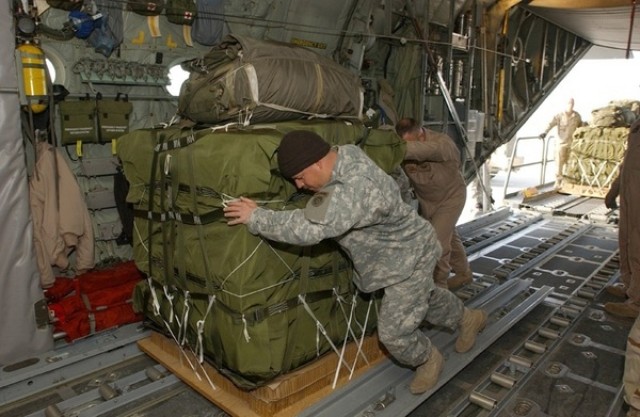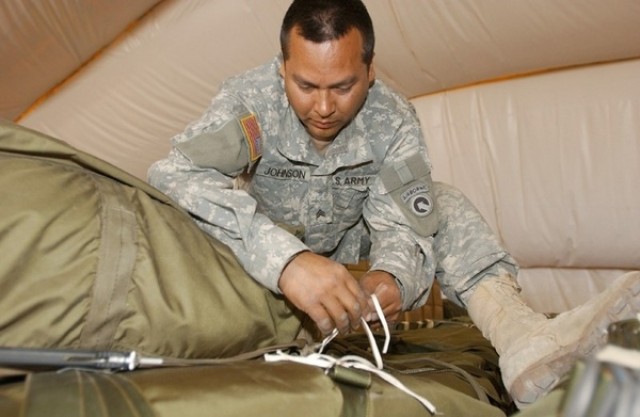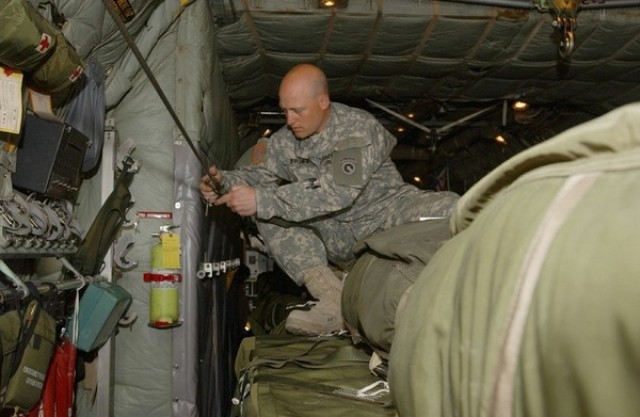FORT LEE, Va. (Army News Service, Jan. 30, 2007) - Parachute riggers are making outstanding contributions to America's war on terrorism in Afghanistan. That's the word from Sgt. Maj. Mary Brown, the top enlisted Soldier at Aerial Delivery and Field Services Department, Quartermaster Center and School.
Brown visited the theater of operations last month to boost Soldiers' morale and returned enthused about what she witnessed.
"I was totally impressed with those Soldiers," said Brown, one of only two rigger sergeants major in the active Army. "If I had the authority to promote each and every one of them on the spot, I would've."
Twenty riggers are assigned to the rigger section of the Combined Joint Task Force at the Bagram Airfield. The Soldiers are from several Fort Campbell, Ky., and Fort Bragg, N.C., units. Their mission is to provide aerial re-supply via containerized delivery systems throughout the country in support of both military and humanitarian operations.
The team has conducted 300 airdrops, and rigged and dropped over 3,000 bundles weighing over 4.5 million pounds while maintaining a malfunction rate of less than one percent, according to Chief Warrant Officer Cortez Frazier, aerial delivery officer in charge of the rigger section.
Afghanistan is a landlocked mountainous country of more than 250,000 square miles, about the size of Texas. The rugged terrain makes it difficult to supply troops by conventional means, so air supply has proved to be an essential component in logistical operations. Riggers pack the parachutes of equipment and supplies for aerial delivery.
According to Brown, the riggers' all-out approach to exceed has been the most critical factor in their success. She cited a short-notice mission requirement as an example.
"One day I was there they were given a mission that they needed supplies within a 10-hour time frame, and they were able to do it," she recalled, noting that the requirements were a pretty tall order for the time frame. "They had everything rigged, loaded onto the aircraft, and got it out to the forward operating bases in the allotted time. And they've been doing that all year."
Frazier said one of the section's major accomplishments was a record-setting mission that took place in the summer.
"June 17, 2006, marked the first time that 40 containerized delivery system bundles were dropped from the C-17 Globemaster in combat operations in one pass over a drop zone," he said. "These bundles were an emergency re-supply in support of offensive operations during Operation Mountain Thrust in Southern Afghanistan."
Missions such as those, said Brown, have earned the riggers a reputation they can be proud of.
"Everyone that I talked to from the task force commander to commanders and sergeants major - across the board - have nothing but excellent comments for the riggers," she said. "They are so proud of the job the Soldiers are doing over there."
Brown said she returned from the trip not only with a sense of pride, but also with ideas to better prepare rigger students for combat operations.






Social Sharing